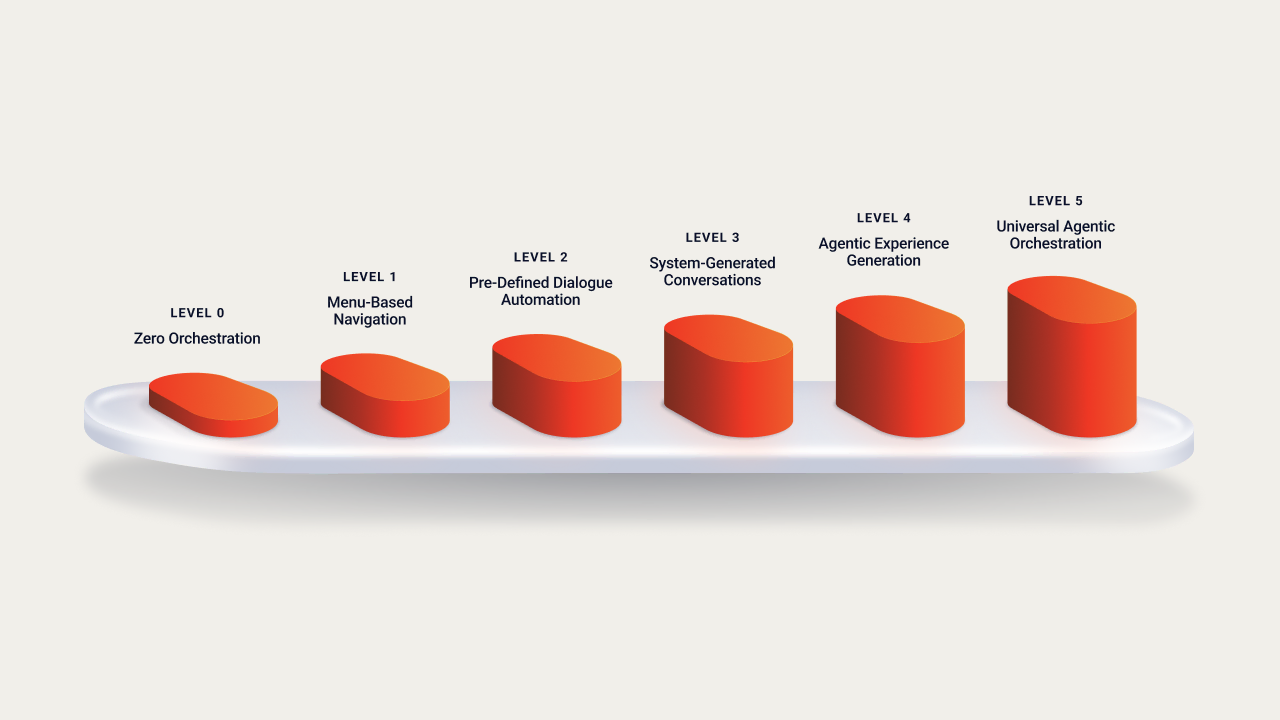Your Genesys Blog Subscription has been confirmed!
Please add genesys@email.genesys.com to your safe sender list to ensure you receive the weekly blog notifications.
Subscribe to our free newsletter and get blog updates in your inbox
Don't Show This Again.

We’re standing at the start of one of the most profound transformations in business history, driven by a new generation of generative and agentic artificial intelligence (AI). These technologies are reshaping how organizations deliver customer and employee experiences by unlocking new levels of automation, augmentation, personalization and optimization.
AI-Powered Experience Orchestration, once a vision of using AI to coordinate experiences across systems and channels, is now becoming reality. In this article, we explore how this transformation is unfolding, including its future potential, and define the six Levels of Experience Orchestration. This maturity model provides a foundation for organizations to assess where they are today, envision what’s possible and build a strategy for AI-powered growth.1
The purpose of experience orchestration is to achieve two objectives at the same time:
Organizations can better balance the tradeoff between operational efficiency and delivering people-centric experiences. The right AI-Powered Experience Orchestration strategy enables both.
By coordinating data, systems, channels and roles, orchestration creates experiences that are more effective, efficient and emotionally intelligent from the perspective of customers and employees. As new innovations emerge, we’re heading toward universal orchestration — transcending customer-facing activities across the front- and back-office — enabling organizations to reimagine the contact center, customer and employee experiences, and their business overall.
The following Levels of Experience Orchestration define the maturity curve from fully manual to fully autonomous orchestration. Each level marks a meaningful leap forward in how automation, augmentation, personalization and optimization are applied and unlocks potential new business value in the form of increased efficiency, deeper customer loyalty and stronger employee engagement.

Customer interactions are entirely manual, handled through basic telephony systems with no integrated tools or intelligence. Human agents rely on training and static documentation. Every interaction is reactive and inconsistent.
There is no unified view of the customer, and no orchestration of tasks or insights across systems. Customer service is treated as an operational necessity rather than a strategic function — leading to high effort, high attrition and poor outcomes
Interactive voice response (IVR) systems provide basic automation with fixed routing logic and limited speech recognition. Customers interact through keypad or voice menus, typically to check status or route to a department. While this reduces call volumes slightly, experiences remain impersonal and voice-bound.
Human agents are still required for most tasks and rely on limited CRM context. Quality control is manual and retrospective. The system operates, but it doesn’t adapt
Conversational AI combines automated speech recognition (ASR), natural language processing (NLP) and natural language understanding (NLU) to engage across multiple communication channels. Interactions are governed by pre-defined rules and scripted dialogues. Predictive AI models are applied to specific use cases (like routing or engagement) but have not yet been generalized to determine next-best actions as part of an experience in general.
Generative AI uses Large Language Models (LLMs) and transformer-based architectures to produce content within the boundaries of its configuration. AI performs tasks it has been explicitly designed or trained to do no more, no less. It enhances experiences through automation, augmentation, personalization and optimization, while still operating within predefined logic and workflows.
This level of AI does not reason or make decisions beyond what it has been instructed to do; it simply executes its programming with increasing breadth and fluency.
AI evolves from simple execution to intelligent problem-solving. Systems are configured for specific objectives and use reasoning, planning and memory to determine how to best accomplish goals while still operating within clearly defined boundaries.
This level introduces agentic AI that interprets context, plans across steps, and adjusts actions based on dynamic inputs. However, all execution remains semi-autonomous. Human input, approval and oversight are still integral, enabling alignment with intent and preventing overreach.
AI reaches a state of goal-driven autonomy, capable of independently planning, deciding and executing based on objectives defined by human stakeholders. Virtual agents, supervisors and administrators are no longer constrained by fixed workflows or linear task execution. They dynamically generate new strategies and adaptively coordinate actions in pursuit of business outcomes, guided by overarching goals rather than rigid instruction sets.
This is the apex of orchestration maturity — where AI transitions from reactive automation to self-directed, collaborative experience management.
AI systems combine LLMs with memory, planning and reasoning, enhanced by continuous feedback loops. Experiences are no longer siloed or transactional, but instead become fluid, adaptive and intelligent across entire ecosystems.
AI entities interact directly with one another, sharing goals, exchanging context and delegating responsibilities, enabling distributed orchestration across both internal systems and external partners. Human involvement becomes strategic and intentional, focused on oversight, governance and complex decisions that benefit from empathy, creativity or judgment.
The Levels of Experience Orchestration maturity model illustrates how businesses can evolve from fully manual operations to intelligent, AI-driven systems capable of independently managing and improving customer and employee experiences. Each level reflects a significant leap in AI capability and the potential value it can deliver — starting with isolated task automation and culminating in systems that can plan, reason and act in pursuit of business goals.
As organizations evolve their experience orchestration maturity, they will often operate across multiple levels at once, depending on business priorities, customer segments, operational constraints and risk considerations. Some experiences will remain highly structured and human-supervised, while others will benefit from increasing autonomy and self-direction.
Critically, the path to maturity also involves the growing collaboration between intelligent systems — AI-driven agents coordinating with one another to resolve complex tasks, share context and dynamically adapt across journeys. These interconnected agents, whether supporting customers, supervisors, or administrators, form the foundation for scalable, adaptive orchestration. In this model, intelligence is no longer isolated to a single system or interaction. It becomes a distributed capability, capable of continuously learning, sharing, and improving across the entire experience landscape.
The Levels of Experience Orchestration provide a structured maturity model to help organizations navigate their transformation journey. We believe most enterprises operate today at Levels 1 or 2. But the path forward is clear — and accelerating.
Organizations that invest in agentic orchestration will be well-positioned to unlock potentially exponential value: greater automation and scale, more empowered employees and deeper customer loyalty.
Where does your organization operate today? What would it take to move up a level?
Genesys is here to help you define that path — and take the next step toward orchestrated, emotionally intelligent experiences at scale.
1 This is a discussion paper, not a product roadmap. Genesys does not commit to delivering any capabilities described in this document.
* This article was originally published on May 14, 2024 and has been updated.

Tony has decades of experience steering business-to-business and business-to-consumer companies through major market transitions and rapid scaling. A passionate technologist at heart, Tony began his career in network operations and internet infrastructure, teaching himself to code during his daily train commute. He swiftly gained the business acumen to advance into trusted executive roles at some of the world’s most respected global SaaS companies.
Career highlights include leading Cisco’s Service Provider business, growing its Enterprise and Commercial division to more than $20 billion in annual revenue and serving as CEO of Skype, where he was responsible for expanding the business to over 170 million connected users. Once Skype was acquired by Microsoft, Tony became president where he was responsible for unified communications before serving as executive vice president of business development and developers. In addition to his role at Genesys, Tony serves on the board of directors at VMWare.
Dr. Peter Graf is the SVP of Strategy at Genesys. In his role, he is responsible for developing, communicating, sustaining the Genesys strategy.
Prior to joining Genesys in 2017, Peter held a variety of executive leadership positions in strategy, development, and marketing throughout his more than 25 years in the global enterprise software industry, most notably as an Executive Vice President at multinational software corporation SAP. Peter earned a doctorate in artificial intelligence from Saarland University and a master’s degree in computer science and economics from Technical University of Kaiserslautern in Germany.
Subscribe to our free newsletter and get blog updates in your inbox.